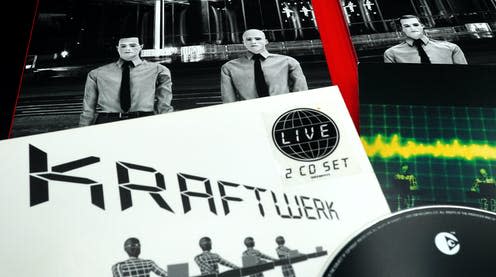Florian Schneider and Kraftwerk helped shape the sound of modern music

There are few bands whose influence was such that it can unequivocally be said that modern music would sound different without them. Kraftwerk, co-founded by Florian Schneider, whose recent death at the age of 73 was announced on May 6, was one such act. The band left an indelible imprint on the sound of popular music by bringing synthesised instruments to the forefront and electronics into the mainstream.
Schneider trained as a flautist at the Dusseldorf Conservatory, which might seem an odd background for a musician whose work did so much to shape the synth-pop and electronic dance music of the 1980s and beyond. But he and band-mate Ralf Hütter – an alumnus of the same music school – exemplified an exploratory approach to music making that traverses musical fields.
Emerging initially from an experimental milieu, their early albums were free-form improvisations that mixed electronic and traditional instruments. Alongside other German electronic acts, including Can and Neu!, they came to represent “krautrock” (as English critics dubbed it) or “Kosmische Musik” (‘cosmic music’, a term used by the German muscians).
The big breakthrough for Kraftwerk (the name means “power plant”) came with the release in 1974 of their fourth album Autobahn. The title track was a sonic depiction of the modernity of long-distance highway travel in their native Germany. Imbued with the sound effects of cars and horns, you could find distant echoes in the lyrics of the driving songs of Beach Boys and Chuck Berry. The album was a Top 10 hit, in Germany, the US and the UK, with a radio edit of the title track – 21 minutes long on the album – confounding expectations by charting as a single in the UK, US, Australia and the Netherlands.
Although some acoustic instruments could still be heard, Autobahn saw the band’s line-up stabilise around Schneider, Hütter and percussionists Wolfgang Flür and Karl Bartos. Its sound crystallised into something precise, evocative, human and yet simultaneously uncanny, laid over rhythmic grooves created with customised electronic instruments.
Influencing the influencers
While subsequent albums, including Radioactivity, Trans-Europe Express and The Man Machine, performed respectably – if not earth-shatteringly – in the commercial realm, Kraftwerk’s true impact was not so much about blazing a trail through the charts as expanding the parameters of popular music and opening up the ears of a generation of innovators to new possibilities. David Bowie’s late 1970s albums recorded in Berlin were heavily indebted to Kraftwerk, and he name-checked its co-founder on V-2 Schneider from Heroes.
Electronically synthesized instruments weren’t new, but had often been regarded as the preserve of experimenters on the commercial fringe, of the soundtrack artists in the more rarefied environs of the BBC Radiophonic Workshop, or as a kind of novelty. Their presence in rock music was tolerated, but rarely celebrated or centralised until Kraftwerk.

Schneider and Hütter paved the way for pop that used electronics as a foundation, rather than a garnish, and cleared the way for the likes of Gary Numan, Depeche Mode and the Human League in the 1980s.
But their shadow was cast much wider than the straight line of synth-driven pop. The exactitude of their tracks, and sonic distinctiveness, made them ideal fodder for the sampling that was emerging as a recording practice. Their songs Numbers and Trans-Europe Express served as the lynchpin of Afrika Bambaata’s Planet Rock at the roots oft the roots of hip-hop. Likewise, techno pioneer Derrick May has been explicit about their extensive influence on the formation of the genre. He would recall their popularity with the originators of techno in Detroit: “They were doing this thing that was from another planet … everybody latched onto Kraftwerk.”
Enriching pop’s sonic vocabulary
Key to their impact, and their work, was that they operated at a tangent to the pop world, as they had with the world of classical music. Their robotic stage act allowed them to eschew the celebrity game and the band, Schneider in particular, tended to be reticent about giving interviews in later years. Running their own studio: Kling Klang – their “electronic garden” as they called it – along with control of their business affairs allowed them to exercise aesthetic autonomy. As they told biographer Pascal Bussy in 2004:
We have invested in our machines, we have enough money to live, that’s it. We can do what we want, we are independent, we don’t do cola adverts, even if we might have been flattered by such proposals, we never accepted.
Their emphasis was on constructing sounds, first and foremost, with an omnivorous approach to source materials and subject matter. “We make compositions from everything,” Hütter told journalst Sylvain Gire. “All is permitted, there is no working principle, there is no system.” Mass appeal, it turned out, was a byproduct.
There’s a degree of irony in a band so tangentially concerned with pop so definitively reshaping it. Their singular approach has yet to be replicated, even as its echoes resound across pop, rock and dance music.
What makes them distinctive is that they didn’t just stand at a crossroads between different generic approaches, but uncovered those pathways, growing popular music’s sonic vocabulary and revealing its boundless capacity for incorporating new ideas.
This article is republished from The Conversation under a Creative Commons license. Read the original article.

Adam Behr has received funding from the Arts and Humanities Research Council

 Yahoo News
Yahoo News 
